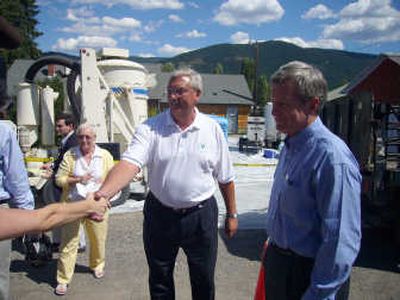Baucus: Libby cleanup bungled

LIBBY, Mont. – A massive federal cleanup of this asbestos-contaminated town has been bungled by bad decisions and political meddling, according to allegations made Monday by Sen. Max Baucus, D-Mont.
Baucus demanded the U.S. Environmental Protection Agency hand over documents that might shed light on why the agency backtracked on its plan to declare a public health emergency for the remote northwest Montana community, where hundreds have died or been sickened by toxic asbestos fibers mined out of a nearby mountainside.
“It’s critical the people of Libby get justice,” Baucus said, standing in front of a house undergoing decontamination. “There is an emergency here. This is nasty stuff, really nasty stuff.”
Baucus was accompanied by EPA Administrator Stephen Johnson, who was making his first public appearance in Libby since taking the helm of the agency two years ago. Johnson, a scientist and career EPA employee, denied charges of political interference and said the agency would work to comply with Baucus’ request for documents by the end of the month. Mostly, though, Johnson just listened as the senator and residents of Libby vented their frustrations.
Clinton Maynard, a local resident and watchdog of the cleanup effort, said the EPA has lost credibility. “They just need to be trashed, dismantled and rebuilt from the ground up.”
Johnson replied, “EPA did not create this problem.”
About 1,800 current and former residents of the area have become sick from the asbestos. The mine closed in 1990, but piles of asbestos-tainted vermiculite from the mine remained scattered throughout town, including on a local baseball field and running track, until the problem received media attention in 1999.
Since then, the EPA has spent $150 million cleaning up the town, including removing 450,000 tons of soil from yards and sucking contaminated insulation from the attics of more than 850 homes.
“That’s progress,” Johnson said.
But Baucus and others say the agency hasn’t gone far enough. Then-EPA Administrator Christine Todd Whitman promised a public health emergency declaration for the town in 2002, according to Lincoln County Commissioner Marianne Roose. The declaration would have provided for a more thorough cleanup and helped hundreds of residents obtain treatment. But the EPA then retracted the offer with little explanation.
Baucus said he smelled political meddling from the White House and pressure on the EPA from W.R. Grace, the company that operated the vermiculite mine and now faces criminal charges at a trial in September, not to mention hundreds of millions of dollars in civil lawsuits from those sickened by its vermiculite insulation.
“We serve the people, not W.R. Grace,” Baucus told Johnson.
Despite repeated formal requests from Baucus, the EPA has failed to turn over records involving the decision not to declare a public health emergency. Baucus is now threatening to issue subpoenas if the documents aren’t turned over by the end of the month. A top EPA official at Monday’s session said her staff has spent 160 hours trying to comply with the senator’s request.
“How many employees do you have at EPA?” Baucus asked.
When he was told 17,000 people worked at the agency, Baucus replied: “I really don’t have a lot of sympathy for the 160-hour defense.”
LeRoy Thom, who spent 17 years working at the vermiculite mine and has since been diagnosed with asbestos exposure, said he wants a public health emergency declared to ensure the town has access to health care. W.R. Grace administers a health care program for former workers and some sickened residents, but Thom said the program is increasingly restrictive and could be cut off at any time.
“We want something that’s here for the generations ahead of us,” Thom said.
The EPA has also failed to establish a cleanup target for homes contaminated by asbestos, according to a 2006 report by the U.S. Office of Inspector General. Although a growing body of scientific evidence suggests any exposure to the amphibole form of asbestos mined at Libby is dangerous, not all the asbestos-contaminated insulation is being removed from homes in Libby.
“Clearly we have to know how clean is clean,” Baucus said.
EPA is now conducting 12 separate toxicity studies, Johnson said. Previously, EPA officials have said they were more concerned with spending limited dollars on the cleanup effort, rather than scientific studies.
But Baucus wondered if the lack of scientific data behind the cleanup was meant to help protect W.R. Grace or the federal government from dealing with the estimated 15 million to 35 million homes nationwide that contain insulation from Libby.
“I don’t mean to be conspiratorial … but something happened deep inside the bowels of the government,” Baucus told a public meeting of about 60 Libby residents Monday afternoon. “I’ve been very frustrated. I don’t know a place in this country where people have been so put upon.”